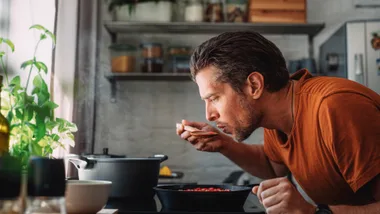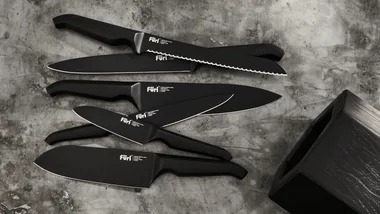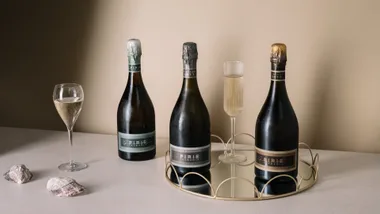Here at GT we take our entertaining seriously, so we quizzed kitchen science guru Harold McGee on the winning formulas for our party ingredients.
Mention science in the kitchen and Harold McGee’s name is sure to come up. He broke ground on the subject way, way before anyone started talking about molecular gastronomy with the publication of On Food and Cooking: the Science and Lore of the Kitchen in 1984. The book’s mix of myth-busting and keen observation, rendered in an unusually readable style, has made it the go-to text for chefs and cooks alike ever since, and McGee’s columns for The New York Times and Lucky Peach magazine make equally fascinating reading.
McGee and British chef Heston Blumenthal have been collaborating for a decade now, and the pair will take the stage together as part of the Margaret River Gourmet Escape later this month. On the eve of his first visit to Australia since the 1990s, we talked to him about the science of entertaining.
Pat Nourse: We pride ourselves in Australia on our barbecuing prowess. What are the keys to success at the grill?
Harold McGee: It really comes down to two things: having different areas of the grill at different temperatures – very high and moderate – and paying attention. It’s so easy not to pay attention when you’re having fun and drinking with friends, but that’s also what generally gives the best results. What I like to do is have one part of the grill as hot as I can get it. That includes a little trick of taking a sheet of aluminium foil and placing it right on the grill above the coals to reflect the intense heat back onto the grill that would otherwise be lost in the air, and it saves you the trouble of cleaning the grill because it instantly vaporises whatever stuff might be left there from last time, and it makes the grill super-hot so you get really nice marks on what you’re cooking. You get the surface the way you want it with the very high temperature and then move the food to the lower-temperature area to cook it through; otherwise you have to time things so that the outside gets to the crustiness that you want at the same time as the inside cooks through, and that’s pretty much impossible, so you have two different heats to do the two different tasks.
Does the order in which you achieve those two goals make a difference?
You can do it either way, and back in the old days, before the invention of the idea that searing seals in meat juices, which was in the 19th century, people would typically cook things very gently and then colour them at the end. But I think, having tried it both ways many times, it’s more practical to do the high-temperature cooking at the beginning, because if you do it at the end, you’ve already got the inside cooked how you want it, and putting it on intense heat means you’re probably going to overcook it.
Are you an advocate of resting meat?
I am, although I have to say one of the great pleasures of a very freshly grilled steak, for example, is to have all those juices come out and then sop them up with a piece of bread. It’s true, though, that if you let meat rest it’ll retain more of those juices and be juicier than it would otherwise.
Turning meat is one of the great stand-by arguments at any barbie – are you a once-and-once-only man?
In the late ’90s I was working with a physicist friend, and we got to talking about food and this issue because one of the things that physicists do is study the diffusion of heat or other materials into a third material, so we ended up writing a computer program to simulate the cooking of meat and then we had the computer do experiments we would never bother doing ourselves, like cooking the meat on one side at a time and flipping once, or flipping every 10 or 15 seconds. We got a very interesting result, which we confirmed by doing the experiment and cooking with a thermocouple probe inside the piece of meat and then flipping it every 10 or 15 seconds. It turns out that the meat cooks a lot faster when you flip it more often, and it cooks much more evenly on the inside. When we thought about it, it made perfect sense: when you leave one side on the heat for a long time, that side gets really hot and the meat right under the surface gets overcooked and then you flip it and do the same thing to the other side. If you flip frequently, the heat has a chance to moderate and travel in when you flip, without overcooking the inside, where the heat builds up in a more gradual way. The downside to flipping frequently is that you have to stand there like an idiot doing nothing but turning meat, and you also don’t get the same high-temperature crustiness on the outside that you’d get just turning it once. I try for a hybrid approach; I leave it on one side for a while to try and get that good crust, and then do it on the other side and then flip frequently towards the end to even it out. The same sort of idea is at work with a rôtisserie – it’s only a tiny portion of the meat that’s exposed to the direct heat at any moment, and then it has the full rotation to absorb it and cool off.
Where does most of the flavour of a good grill come from?
What makes grilling special as a cooking technique is the very high temperature that the surface is exposed to, so most of the grill flavour is created by temperatures in the hundreds of degrees, contact with the metal of the grill, which transmits heat very, very quickly, and the reactions caused by the heat between the proteins, fats and carbohydrates on the surface of the meat which generate those dark colours and rich flavours. Grilling is the best technique to use if your piece of meat is not that special. If you have a really beautifully aged steak, then the flavour on the inside is going to be pretty amazing, too, and the flavour on the outside is the icing on the cake. With a standard piece of beef, what makes it special is that high-temperature cooking on the outside.
What usually happens is that the fat ignites as it drips onto the coals and gives you the flavour of the fire intensified. You don’t want to overdo that because it can get sooty, but a little bit of that is wonderful. The juices themselves are water plus all these flavourful things that exist in the meat – the proteins, the sugars, the salts and so on – and what happens with them ideally is that the heat is so intense that the water evaporates immediately and all those other things concentrate on the surface and then begin to react with each other.
Sausages: to prick or not to prick?
On the grill, the problem with pricking is that you’re going to lose the fat and because there’s so much of it in sausages (they’re in the order of 30 per cent fat) you’re going to end up with a lot of flame, your sausages are going to shrink, and you’re going to lose a lot of flavour. I advise being much gentler than people tend to be. I like to poach them first in water that’s maybe 60C or so, or maybe beer instead of water, and then let them cool down, and just use the grill to warm them up and flavour them – that way they’re cooked through, but they still have their fat.
I always add water to the ice in the Esky to chill beer faster. Is this the best move?
Yes, the water improves the contact and enhances the flow of heat from the warm things to the cold things. The only problem with adding water is that the coldest you can get those beers is just above the freezing point of water. If you add salt and turn the liquid into a brine, though, it’ll have a lower freezing point than pure water, and that means that the temperature of the ice-water mix will drop below zero degrees and make your beers colder much faster. The more salt you add, the lower the freezing point will go. We’re talking fistfuls rather than teaspoons.
Is there much difference with cans and bottles?
If you give them enough time they’ll both reach the same level of coldness, but that thin layer of aluminium transmits heat much faster than glass does, so a can will cool off much faster, but it will also warm up much faster in your hand. To my way of thinking, ideally you’d have a bottle that you’d left on ice long enough to get as cool as a can, and then when you take it out the glass acts as an insulator.
Or get a stubby holder. They really work.
They really do. I’ve gone through many in my life.
Putting a spoon in the neck of a bottle of bubbles to stop it going flat is total nonsense, right?
It actually comes from France. That doesn’t mean that it’s correct, but it comes with a pedigree. I first heard this years ago, and I immediately thought “what a great excuse for a party” because to do the experiment properly you have to have bottles with spoons, bottles without spoons, bottles that have been recorked, bottles that are fresh so you can compare their level of fizziness with the originals you opened. So you’re already talking four or five glasses per person, and then lots of people so you get good statistics. We actually did this. A chemistry professor at Stanford and I ran the experiment, which was great fun. What we discovered was, as you’d imagine, sticking a spoon in the neck of a bottle was essentially the same as leaving it open. If you recork it, you keep more of the bubbles than if you leave it open or put a spoon in it. But what we found was there are a lot of wines in the world where leaving them open is better than recorking them, because the flavour actually improves greatly if you put them back in the fridge for a few hours or overnight. When we left a bottle of American sparkling wine open it was greatly improved, but if we left bottles of Champagne, their quality declined and they were better recorked.
We never nailed the action completely but our sense was that American sparkling wines are much more carbonated than French sparkling wines, so they don’t suffer as much from losing some gas, and then they also tend to have off-flavours, which may be partly associated with that over-carbonation, or it may be something altogether different. These unpleasant flavours blew off with the gas overnight and weren’t as obnoxious the next day. I was never able to track down the origin of the myth, but I know that it was taken seriously enough in France that in the early 1980s the professional organisation of Champagne makers – I forget the exact name – published a study much more serious than the one the physics professor and I did, where they took pressure measurements in bottles before and after various treatments. They also weren’t able to pin it down, but they said that it was widely believed in France, and they thought it was time to put it to rest so people’s Champagne experiences wouldn’t suffer any more.
Hangovers: has science come up with the goods yet?
This is something I check into every couple of years, hoping that science will have come up with a definitive answer, so I took this interview as an opportunity to search the literature again, and I’m afraid things haven’t changed much in the last couple of years. There’s a wonderful paper where someone combed through the medical literature and listed all the remedies that have been reported and tested; and there are probably 30 of them, which tells you that we really don’t understand it very well.
There’s abstinence, but hair of the dog also works because it turns out that the symptoms of the hangover peak at the moment when the body’s blood-alcohol level reaches zero, so if you can keep it above zero, you’re better off, except that you’re forestalling the inevitable, and you’d have to keep that up for a lifetime to avoid it. This is also difficult to do if you need to sleep.
A hangover comes down to a couple of different things. Part of what’s going on is a simple withdrawal effect. Alcohol is a drug. Your body adjusts to the presence of the drug and once you take it away it has to readjust to get back into balance. Alcohol itself has some disturbing effects on metabolism, but then the compounds it breaks down into have effects on our system that cause general dehydration, inflammation and low blood sugar. Those are the main contributors to feeling crappy. What you can do about that is drink liquids to make up for the dehydration and then eat to make up for the low blood sugar. You can deal with the inflammation to some extent with anti-inflammatories such as aspirin, but they also have side-effects; they can irritate the stomach, for example, so you’re trading one irritation for another.
And what about the existential dread?
That’s a good question. I have not delved into that literature, but, speaking from personal experience, when you’re high, all is right with the world, and when you’re hungover, all is wrong with the world. You were feeling wonderful and you have a vague memory of what that was like, but it’s no longer like that, and you’re not sure you’re going to make it to the next minute.
Do you have a party trick?
Sort of. It’s a fairly standard one – I can sabre Champagne bottles. There’s really one technique that works, and that’s to take a chef’s knife with a reasonable heft to it (actual sabres not usually being available) and then the most important thing is to point the bottle away from everyone. Nine times out of 10 it works just fine, though, and it doesn’t even have to be that hard – you just slide the blunt end of the knife along the neck of the bottle.
Catch Harold McGee at the Margaret River Gourmet Escape, 22-24 November. Visit McGee’s website.
 Antonia Pesenti
Antonia Pesenti




-(10).png?resize=380%2C285)



